The History Of Subaru Outback

The Subaru Outback is an all wheel drive crossover manufactured by Subaru since 1995 in sedan and station wagon body styles.
All vehicles with an "Outback" badge are equipped with AWD; there were no versions built with only front wheel drive.
Subaru introduced the Outback to the same markets where the company marketed the Legacy, using the name Outback, except in Japan, where it was known as the Legacy Grand Wagon — then renamed Legacy Lancaster in model year 1997; then renamed again in 2005 as the Legacy Outback.
The name Outback derives from the remote, arid areas of Australia. Australian actor Paul Hogan served as spokesman for the Outback for several years.
The popular British car program Top Gear declared the Outback, along with the Ford Mondeo, as the best car of 2007 in their awards ceremony at the end of Season 10.
The Outback was available in Japan from 1995 as the Legacy Grand Wagon, and in the US and Australia as the Legacy Outback, a trim package with normal ground clearance but an "SUV look" with two-tone paint and fog lights. For MY 1994, the Legacy wagon was available as the Alpine Sport and Sun Sport, which were Value Option Packages included on the "L" trim level wagon, and graphics denoting the option package installed. The exterior was designed by Olivier Boulay, who was hired by Subaru on a short-term basis. It became a separately-marketed line in the United States in 1996. At this point it gained Outback-specific changes included unique bumpers (with large driving lamps incorporated into the front bumper), tweed-like seats and door panel inserts, taller tires with more aggressive tread, and a slightly higher ground clearance.
In September 1997, the Japanese Legacy Grand Wagon was renamed Legacy Lancaster though 1998 cars retained the Grand Wagon nameplate along with the new Lancaster plate. The JDM Grand Wagon and Lancaster were only available with the DOHC 2.5 liter engine, receiving a 10hp (7.5kW) improvement in 1998. Hood scoops found on some Outback sedans and wagons are non-functional as Subaru did not install the turbo into any first generation Outback vehicles sold in the USA. Some Japanese-spec Grand Wagons came with digital climate control, plaid seat upholstery, a dual-range manual transmission and a Momo black leather steering wheel.
Subaru sales had been declining up until that point in North American market. With the help of clever marketing, a trim level called the Outback intent on making the Subaru a more capable multi-terrain vehicle offered an affordable and fuel efficient alternative to the popular SUVs that were outselling Subaru's traditional offerings.
The Outback SUS (for "Sport Utility Sedan") was launched with a limited production test run sold in New England (USA) in 1998 and based on its success, was rolled out nationwide the following year. This included all the Outback wagon upgrades applied to a sedan body, with the addition of a (non-functional) hood scoop and trunk mounted rear wing. The wagon had no special designation or market distinction. The "SUS" moniker was removed with the introduction of the Second Generation.
Over the years since its introduction, Subaru has incorporated the Outback nameplate variously to the Outback wagon itself, and an Impreza-based Outback Sport model. All American Outbacks are built at the Lafayette, Indiana location.
The 4 speed automatic transmission had a feature where the transmission could be instructed to ignore 1st gear from a standing stop to assist driving on traction limited situations, such as ice and snow. The system was activated by depressing a button on the gearshift selector marked "Manual" and moving the gearshift from the "D" position down to "3rd". The car would then start in 2nd gear, and not 1st, then as the car gained speed would shift up to 3rd, locking out 4th gear. The transmission also splits the delivered torque 50-50 between the front and rear wheels. Once the car stopped, the transmission would start back in 2nd and not 1st, until the system was disengaged with the "Manual" button or upshifting to 4th.
The automatic transmission used on AWD equipped vehicles would normally send 90% of the engines torque to the front wheels and 10% to the rear wheels, using a computer controlled, continuously variable, multi-plate transfer clutch. When the front wheels began to experience a loss of grip, the transmission automatically sent available torque to the rear wheels, up to 50-50 split between the front and rear wheels until grip was reestablished at the front wheels, without notifying the driver or occupants that torque was being redirected. When accelerating or driving uphill, the vehicles weight shifts rearward, reducing front wheel traction, causing the transmission to automatically send torque to the rear wheels to compensate. When braking or driving downhill, the vehicle's weight shifts towards the front, reducing rear wheel traction. The transmission again compensates by sending torque to the front wheels for better steering control and braking performance. If the automatic is placed in Reverse or "1st" gear, the transmission divides the torque 50-50 to both front and rear wheels.
The automatic transmission also has engine over-rev protection by shifting the transmission to the next available gear once 6500 rpm has been achieved, even if the gear selector is in a low gear position. The computer that monitors and controls automatic transmission operations and status is networked with the fuel injection management computer, as well as the cruise control and anti-lock brake computer, if so equipped. Information is shared so that the vehicle operates as efficiently as possible. The computers that monitored various conditions also have the ability to store occurrences of possible malfunction, and aid qualified mechanics in the diagnosis and possible repair of various systems.
An unusual interior change placed the power window switches flat against the door panel, whereas the window switches for the first and third generation Legacy, for which the Outback is based, extended from the door panels and were oriented in a horizontal position and were located underneath the drivers or occupants hands for easy location and use, and integrated into the door pull and armrest.
Trim levels in the USA can be distinguished by the color of the outside door handles, with black plastic used on the base level and painted door handles used on the Limited, a tradition that continues to the current model.
Plastic side cladding was not present on the side doors of the Outback; the lower half of the doors were painted a contrasting color also found on the front and rear bumper covers.
Subaru marketed the Outback as "The World's First Sport Utility Wagon ©," despite AMC's having launched in 1979 its own Concord-based AMC Eagle — a 4-wheel drive wagon that pre-dated the term "Sport Utility".
Head gasket issues
Some owners of the newly developed DOHC 2.5 engine for this generation have experienced leaking head gasket issues, which were addressed and much improved on the Second Generation models, when the engine architecture reverted back to SOHC.
Although based on the third generation Legacy, in 2000, Outback became its own model and continued offering the 4-door sedan, as well as an available horizontal six-cylinder engine. The Outback was called the Lancaster in Japan for the second generation, with the six-cylinder in Japan called the Lancaster 6. The USA-spec Outback sedan was available in the "Limited" trim level only. Curiously, the rear seat on the Outback sedan does not fold down, unlike previous generations where the rear seat had a 60:40 folding seat for extended length items. Rear headrests are now included as standard equipment on all trim levels, using cloth interior for the base level model and leather for the Limited. For MY 2000, the rear wiper does not have an intermittent setting, and the MY 2001 has an intermittent setting only. The clock is displayed at the bottom of the tachometer for MY 2000, and for MY 2001 the clock is integrated with an outside temperature display at the bottom of the tachometer.
The six-cylinder was offered with Subaru's VDC (Vehicle Dynamics Control) system, which integrated stability control with traction control. The system was also mated to previously used Japanese-market AWD system, called VTD, in which power was split 45/ 55 front-to-rear in normal conditions. When wheel spin is detected, the system cuts power to the spinning wheel and directs power to those that aren't. Only when necessary do the brakes slow the affected wheels, when the vehicle detects excessive oversteer or understeer.
Other models retained the typical AWD layouts seen in previous generation Outbacks, depending on transmission choice. Manuals came with a mechanical "Continuous AWD" system which was normally 50/ 50 front/ rear, and relied on limited slip differentials to redirect power front to rear, rear to front, and from one rear wheel to the other (when fitted with a rear limited slip differential). Automatics had an electronically-controlled AWD system that was 90/ 10 front/ rear and redirected differing amounts of power to the rear wheels continuously. When accelerating or driving uphill, the vehicles weight shifts rearward, reducing front wheel traction, causing the transmission to automatically send torque to the rear wheels to compensate. When braking or driving downhill, the vehicle's weight shifts towards the front, reducing rear wheel traction. The transmission again compensates by sending torque to the front wheels for better steering control and braking performance. If the automatic is placed in Reverse or "1st" gear, the transmission divides the torque 50-50 to both front and rear wheels.
The 4 speed automatic transmission, had a feature where the transmission could be instructed to ignore 1st gear from a standing stop to assist driving on traction limited situations, such as ice and snow. The system was activated by moving the gearshift from the "D" position down to "2nd". The car would then start in 2nd gear, and not 1st. The transmission also splits the delivered torque 50-50 between the front and rear wheels. Once the car stopped, the transmission would start back in 2nd and not 1st, until the system was upshifted to 4th.
The automatic transmission also has the ability to change the shift points, and hold the gears longer when the engine is operating at higher RPM's. This is achieved by pressing the accelerator pedal rapidly, which causes the transmission to hold the gear until 5000 rpm before shifting to the next gear. No indicator light appears in the instrument cluster, unlike previous generations. The transmission also has engine over-rev protection by shifting the transmission to the next available gear once 6500 rpm has been achieved, even if the gear selector is in a low gear position.
The Outback came standard with a 165hp (123kW) by SAE, 4-cylinder boxer engine, however it differed from the previous four-cylinder in that it reverted back to the SOHC design; that, and maximum torque (166lb·ft (225N·m)) was available at a lower rpm. The 2.5 L SOHC four cylinder engine uses a timing belt that must be replaced around 100,000miles (160,934.4km), whereas the 3.0 L six cylinder engine uses a timing chain that doesn't require replacement under normal conditions.
In the highest trim level, known as the Outback L.L. Bean in the USA, a 200 W McIntosh stereo system was standard from 2001 to 2003. These were some of the only vehicles ever factory-equipped with McIntosh stereo equipment. Options also included an in-dash 6-disc CD changer, (VDC, for Vehicle Dynamics Control), and dual moonroofs. The L.L. Bean trim level can be distinguished from other trim levels by the color of the lower body cladding and bumper covers, which are painted the same color as the sheet metal, instead of contrasting colors, a recognized Outback appearance tradition. <<Some L.L. Bean Edition Outbacks WERE available with the two-tone body cladding. For instance, the 2002 L.L. Bean Edition Outbacks were available with the two-tone body cladding (with beige cladding) when the specialty color of metallic purple-black was ordered.>> OnStar was available as an option on the USA-spec L.L. Bean.
Australian delivered Outbacks
Australian-spec vehicles differ from cars delivered in the United States by following the Japanese models; primarily headlights, side indicators (on front quarter panels), rear taillights, front and rear bumpers and a higher placing of the "Outback" badging on the front door bodywork (as opposed to being placed on the plastic cladding).
This generation of Outback was released in an early style with gold coloured cladding, all-in-one headlights (not dissimilar to the US model headlights) and internally a light gray cloth (sometimes speckled with various colours), a light brown wood textured dashboard and a plain instrument cluster. A nudge bar (a smaller style of bullbar or roobar) was also available as an aftermarket option. The later style (2002-2004) was updated with silver cladding, an updated range of paint colours, multi-unit headlights (where headlight and indicators were in different sections of the unit) and internally a dark gray/ black cloth, dark gray plastics, a very dark brown faint wood texture and metal trims on the dials of the instrument cluster.
Models available included the base "Outback", the "Outback Limited" which added a sunroof and cloth/ leather seats and the "Outback H6" which included the 6 cylinder engine with VDC as described in this article. The H6 was released with slightly different 16" wheels and available in a single metallic pearl off-white colour instead of the usual colour with gold or silver cladding. The H6 was only available in automatic, apparently due to the size of the 6 cylinder engine taking up too much space to fit the manual box and associated dual range mechanicals.
In 2003, with the debut of the fourth-generation Legacy at the 60th Frankfurt Auto Show, the Outback name is now being used worldwide (Australia, Europe, Japan and USA) with the launch of the third-generation Outback wagon. Models equipped with a 3.0L H6 were introduced at the 2004 Chicago Auto Show.
Plastic side cladding was reduced half way below the door rub strip on the side doors of the Outback; only the plastic cladding on the doors were painted a contrasting color also found on the front and rear bumper covers.
The Outback carries the same model codes as the Legacy Wagon, BP9 for the 2.5 liter, and BPE for the 3.0 liter model. The highest trim level offered in the USA is the Outback L.L. Bean that offers optional equipment as standard, including wood and leather steering wheel, an auxiliary port on the stereo for MP3 compatibility, perforated leather seats, GPS navigation, double sized, one piece, glass moonroof and the H6.
A new Outback variant for 2005+ is the Outback XT. This model comes with Subaru's turbocharged 2.5L 4-cylinder engine found in the Impreza WRX model. This engine produces 243 hp, which is much higher than the naturally aspirated 2.5L producing 175 hp. The XT model can be equipped with any of the 3 standard transmissions: 4-speed Auto-SportShift, 5-speed Auto-SportShift, or 5-speed manual.
Starting in July 2008, Subaru will no longer offer a special edition L.L. Bean trim level on the Outback.
Subaru beefed up their AWD 4EAT transmission's design and released the 5EAT w/ SportShift in 2005
The Outback received styling revisions for the 2008 model year, notably an enlarged, chrome-ringed grille.
As of the 2008 model year, the Legacy wagon and Outback sedan were discontinued in the United States, leaving the Legacy sedan and Outback wagon.
The JDM and EU diesel model has a "Start/ Stop" button ( in the top-of-the-line-modell), found in Lexus, Infiniti, Audi and other high end makers.
For 2008, the 2.5i USA model has been certified PZEV emissions, and a badge has been attached to the rear of the vehicle on the bottom right hand side of the tailgate. All other models are certified LEV2.
EyeSight
On May 10, 2008, the Japanese-spec Legacy can be fitted with a new safety feature called EyeSight. It consists of two cameras, one on each side of the rear view mirror, that use human-like stereoscopic vision to judge distances and generally keep tabs on the driver. The system helps maintain a safe distance on the highway, warns the driver during unintended lane departure, emits a wake up call should everyone else pull away from the traffic lights, and keeps an eye out for pedestrians. SI-Cruise has been integrated into the EyeSight feature as a driver safety aid.
Diesel
The flat-4 diesel engine is offered in both the Legacy and Outback sedans and wagons, identified as the Subaru Outback 2.0D the vehicle was released in the EU starting March 2008. The vehicle is offered with a 5 speed manual transmission only.
The official introduction of the Legacy and Outback diesel was at the Geneva AutoShow in March, 2008.
According to the Subaru Owners on-line newsletter dated March 2008, Subaru is "currently making modifications to the diesel so it meets the more stringent U.S. standards. Subaru diesel models should be domestically available in two to three years."
The Outback badge is used for Subaru vehicles that offer a crossover, off-road, all-weather capability based on the Legacy-Liberty wagon or Impreza Sport Wagon.
The Outback Sport was first introduced in 1995 as an updated Impreza "L" Sport Wagon, and is currently offered only in the USA. The Outback Sport package was never available on the Impreza sedan or coupe from Subaru, unlike the Outback package being available on both the Legacy-based sedan and wagon.
One engines was offered, which was the 2.2 liter, and it was the first time the 2.2 engine was used in the American Impreza. Later, the 2.5 engine was introduced. In Japan, the Impreza Sport Wagon was offered with a similar approach to the Outback Sport, calling it the Impreza Gravel Express with the WRX turbocharged engine. Subaru discontinued the Gravel Express when the second generation Impreza was introduced due to very limited sales, and introduced the Subaru Forester as a replacement. The hoodscoop found on the American Outback Sport was non-functional but was probably included because the American and Japanese versions were built at the same factory in Japan. The Outback Sport was offered with optional equipment, such as a gauge pack installed on top of the dashboard, that included a digital compass, outside temperature and barometer or altimeter readings.
The Second Generation Outback Sport was sold in Australia for MY 2001-2007, but it was renamed as the Impreza RV with the same color scheme as the American version . The Australian version had a dual-range manual transmission, not available in the USA.
Subaru found some sales success with the Outback Sport as a smaller companion with similar ride height changes, body colors and trim levels to the larger, more successful selling Legacy based Outback. The Outback Sport "incorporates the performance features of an Impreza with the rugged durability of the Outback" according to the Outback Sport website, continuing to offer it as a trim option of the Impreza, with exterior cosmetic and interior equipment modifications.
It is an alternative for buyers who don't like the SUV/ CUV appearance of the Forester and don't need the extended ground clearance. The Outback Sport has been offered for the same amount of time as the larger Legacy wagon based Outback, but the larger Outback has seen more sales than the smaller Outback Sport. Mechanically, the Outback Sport is the same as the standard Impreza hatchback; no high performance equipment found on the Impreza WRX or STi is included on the Outback Sport.
Outback Sports can be easily identified from the standard Sport Wagon or newly released 5 door hatchback by the color of the front and rear bumper covers and matching door rub strip that are painted a contrasting color from the paint used for the rest of the car, a coloring scheme also used on the larger Outback.
Subaru Outbacks have been winners of the Alcan Rally, an endurance race that starts in Seattle, Washington to the Arctic Circle and back. An Outback wagon won the race in 2002, driven by Gary Webb, Richard Mooers, and John Kisela and again in 2006, driven by Revere Jones, Brian Deno, and Tom Gould.
From Wikipedia, the free encyclopedia
More About Subaru Outback
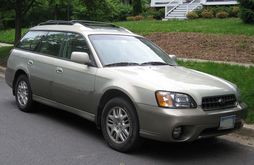
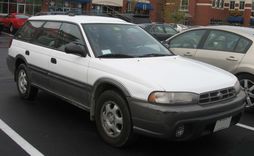
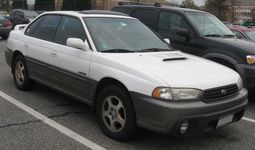
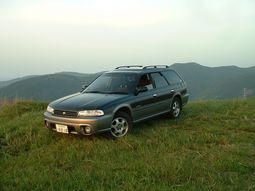
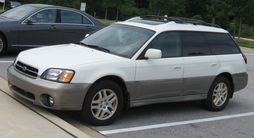
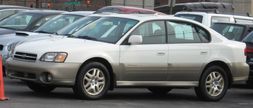
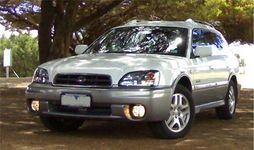
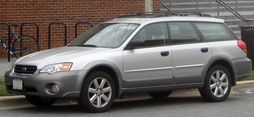
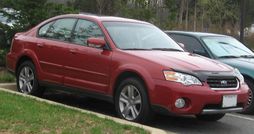
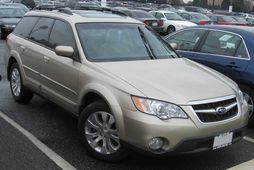
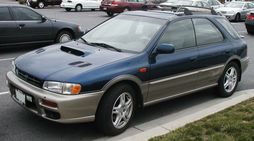
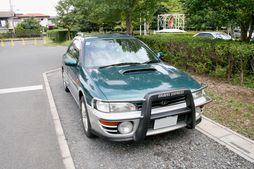
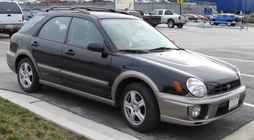
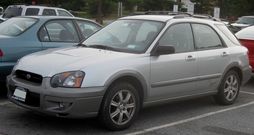
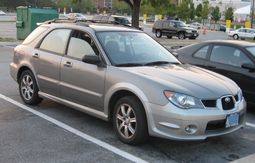
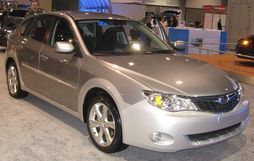
|